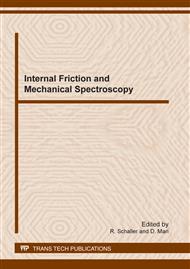p.239
p.245
p.251
p.257
p.265
p.271
p.277
p.283
p.289
High Temperature Mechanical Spectroscopy Study of 3 mol% Yttria Stabilized Tetragonal Zirconia Reinforced with Carbon Nanotubes
Abstract:
Composites containing 3 mol% yttria stabilized tetragonal zirconia (3Y-TZP) reinforced with multiwalled carbon nanotubes (CNTs) with various amounts of CNTs (3Y-TZP / X wt% CNT, X= 0, 0.5, 1.5, 3 and 5) were processed by spark plasma sintering. Microscopic analysis proves that CNTs were well dispersed and embedded in grain boundaries of the sintered body. High temperature mechanical properties have been investigated using mechanical spectroscopy and low stress (6 MPa) creep. The isothermal spectrum (measured at 1600 K) consists of a mechanical loss peak at a frequency of about 0.1 Hz, which is superimposed on an exponential increase at low frequency. The absence of a well-marked peak in monolithic 3Y-TZP is justified considering that restoring force decreases at low frequencies or high temperatures due to the elasticity of neighboring grains. Therefore, strain is no more restricted and the mechanical loss increases exponentially, which is correlated to macroscopic creep. However, with CNT additions the mechanical loss decreases and a better resolved peak was observed. In parallel, the results have shown that the creep rate drastically decreases with CNT additions. These results can be interpreted by the pinning effect of CNTs which can hinder grain boundary sliding at high temperatures, resulting in a creep resistance improvement.
Info:
Periodical:
Pages:
265-270
Citation:
Online since:
January 2012
Authors:
Price:
Сopyright:
© 2012 Trans Tech Publications Ltd. All Rights Reserved
Share:
Citation:


